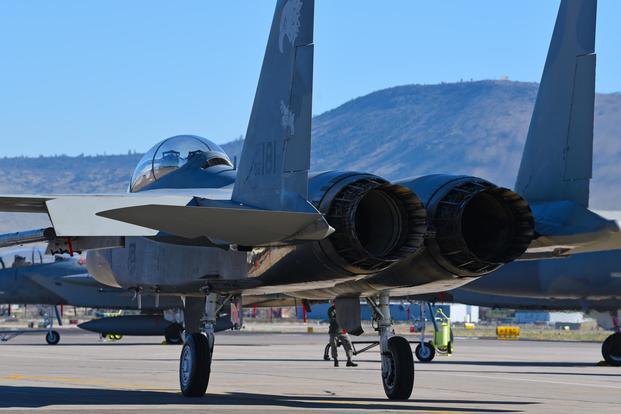The U.S. Air Force says it stood down a portion of its F-15C/D Eagle fleet at an Oregon base earlier this year partially due to lost paperwork, not over structural issues with the aging aircraft, Military.com has learned.
The issue originated during a depot overhaul of one Air National Guard F-15 belonging to the 173rd Fighter Wing at Kingsley Field, which prompted the wing's commander to stand down the fleet on March 23, Air Force Materiel Command spokesman Brian Brackens said Thursday.
"At that time, it was discovered that some inspection documentation was missing from a previous inspection of an aircraft longeron," Brackens said, referring to the sole F-15 receiving depot maintenance.
A longeron is a beam in the aircraft frame.
Related content:
- Air Force Grounds All F-15C Fighters at Oregon Training Base
- Engine Part Blamed in F-16 Crash Had Failed Inspection Twice
- Aviation Accident Spike Has Services Scrambling for Solutions
"For aircraft safety, the F-15 program office decided to re-accomplish the inspection in order to assure integrity of the longeron prior to allowing the aircraft to continue flying past its scheduled depot input," he said in a statement.
Military.com requested additional information after Col. Jeff Smith, commander of the 173rd, grounded the fleet of 30 F-15s in March over what the wing described as "pilot safety concerns" regarding significant maintenance issues affecting the aircraft's structure. Military.com was first to report the inspection issue.
Brackens said other maintenance issues, however, came to light on the aircraft receiving the maintenance check.
"Other non-related maintenance issues led [Smith] to pause operations for the remainder of their fleet," he said without providing specific details. Brackens did not respond to a request for the details by press time.
At the time, it was unclear if the problem pertained only to F-15s at Kingsley, or if it would lead to a service-wide inspection of all of the 1980s-era aircraft.
Brackens on Thursday said it did not prompt a fleet-wide service check or an additional structural overhaul.
"No fleet-wide inspection was issued for structural inspections before or after the Kingsley stand-down," he said. "All critical aircraft structures are regularly inspected during planned phase inspections at the operating bases and also during programmed depot maintenance."
He added, "No fleet-wide groundings are currently required, and the aircraft are safe to fly."
Kingsley Field in Klamath Falls is home to the only F-15C training schoolhouse in the Air Force, a robust training program for both active-duty and Guard pilots. The 173rd also houses a few D aircraft models.
Though the maintenance issue did not prove to be systemic, "there has been a couple of F-15 aircraft in the unit's possession that in the future will require either a canopy sill longeron, aft canopy sill longeron, or upper inboard longeron to be replaced," Brackens said.
He added, "but this is typical of an aging aircraft."
In 2007, the Air Force grounded its entire F-15 fleet after a fighter from the Missouri Air National Guard broke apart mid-air and crashed. The pilot ejected.
Investigators found the cause of the crash to be a faulty longeron.
Engineers concluded that the longeron -- part of the multi-fastened support beams that work as building blocks within the aircraft's fuselage -- had cracks in it, and that there had been no proper maintenance procedures to detect the deficiency, according to the 2008 Accident Investigation Board report, CBS News reported.
The service conducted a nearly three-month inspection of the F-15 fleet.
According to the Air Force's fiscal 2018 budget request, it asked for roughly $7 million just for service life extension, or SLEP, on the support beams.
"The longeron SLEP entails replacing 14 primary tension members in the structure of the forward fuselage and is critical to the safety of flight of these aircraft," according to the budget documents. "There are other structural issues with the F-15Cs besides the longerons, and full-scale fatigue testing is ongoing to assess these matters."
Brackens said the F-15 Program Office plans to begin the longeron replacement program for the F-15C/D fleet in 2020.
"Until the program is ready to execute, the aircraft are kept safe through regular inspections and repairs by field and depot personnel," he said.
However, it's possible officials could announce a retirement of the service's F-15C/D models -- a decision it's been weighing for months -- before the work begins.
Last March, officials told lawmakers they were looking at possible plans to retire the two models as early as the mid-2020s.
Air National Guard Director Lt. Gen. L. Scott Rice at the time said the Air Force as a total force was in "deep discussions" regarding the retirement, with plans to further assess the F-15 inventory in 2018.
Rice and other Air Force officials said the F-16 Fighting Falcon would take over in the multi-mission role.
The service has 212 F-15C and 24 F-15D models, according to the Air Force Association's 2017 aircraft inventory almanac.
The single-seat F-15C and two-seat F-15D models entered the Air Force inventory in 1979 and have been in almost every theater across the globe.
Editor's note: this story has been updated to correct how the Air Force referred to the F-15 operational pause.
-- Oriana Pawlyk can be reached at oriana.pawlyk@military.com. Follow her on Twitter at @Oriana0214.










